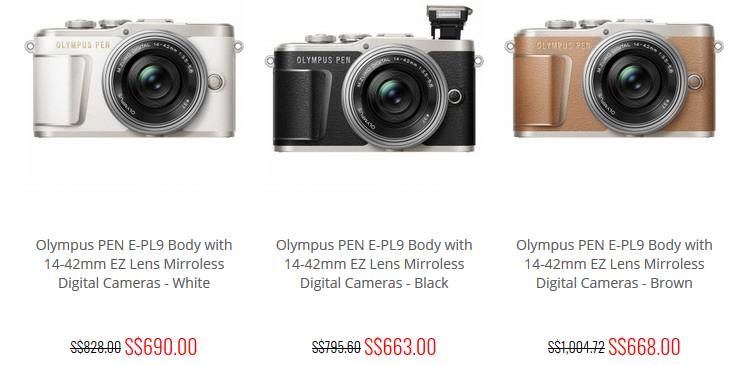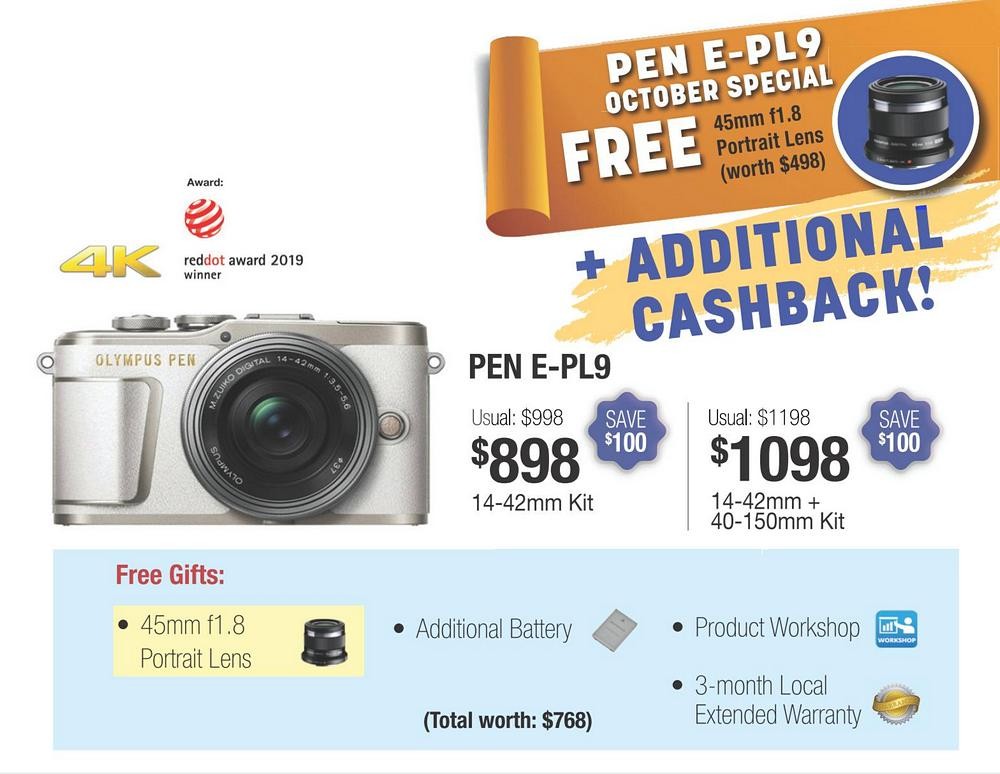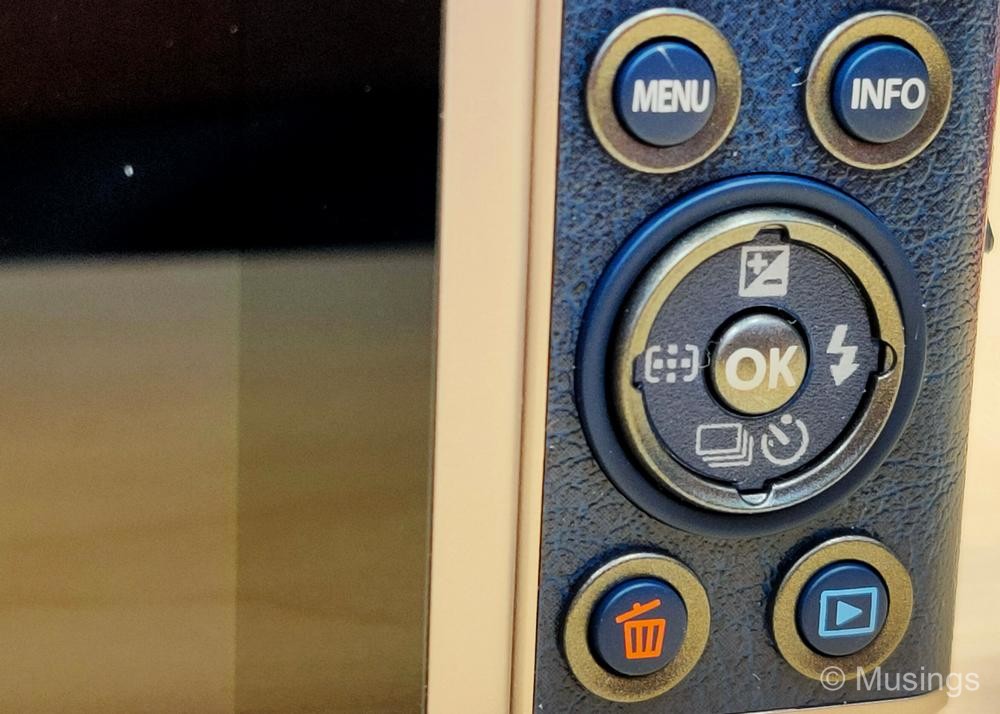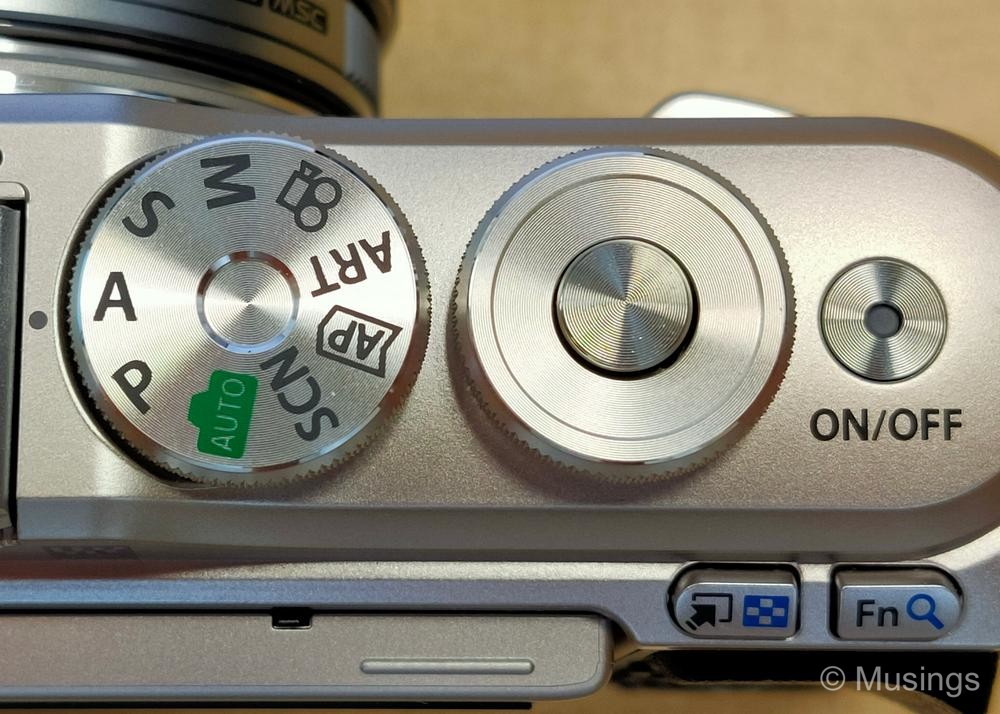Continued from the last post – my early handling notes and first impressions of the new E-PL9!
The normal retail price of the E-PL9 with the EZ14-42mm kit lens is SGD998, but it’s also just recently seen a significant price cut to SGD898 – I reckon on account of the just announced E-PL10, of which first indications note it to be not offering significant advancements from the E-PL9. Tecobuy, a Hong Kong-based online retailer I frequently check to see what are street prices of camera gear there, lists the item for about SGD660, and occasionally discounts it to SGD620. Warranty and servicing claims will obviously be a challenge – and the several mechanical failures on the E-PL6 made me a little leery about buying a unit without local warranty support. Still, it was quite a significant price difference, though I’d have to add import tax to the price if it gets shipped here.
I finally went with purchasing it here in Singapore and at SGD817. It’s a bit more than having it shipped here from Tecobuy. But in return, I got a small sling bag, 15 months of warranty, an additional BLS-50 battery (more on that later), and a new copy of the Olympus 45mm f1.8 lens – a lens I really enjoyed when I was solidly in the m4/3 system. The last three of four freebies are not trivial: the lens itself lists for around SGD320 on Amazon – though there are so many new and pre-loved copies of the lens on sale here in Singapore that I’d need to ask for a lot less in order to get any kind of purchase interest.


There are three normal color variants of the E-PL9 – white, black and brown – and a super cool-looking blue denim special limited edition version. The latter was a little hard to find with most stores either not carrying it or well out of stock since the camera has been on sale since Feb 2018. But I found one brick and mortar store that had one last last unit of this variant, and picked that up. I really like the silver/chrome trims of the E-PL9 in this model – the E-PL line has previously offered mono-color variants, e.g. all black – and the body looks odd when fitted with silver variants of my favorite lenses, e.g. the Olympus 17mm f1.8.
I picked up the E-PL9 with the standard kit lens: the Olympus M.ZUIKO Digital 14-42mm f3.5-5.6 EZ. Not that it’s a lens I’ll actually use a lot – I intend for this replacement E-PL body to be used with the Olympus 17mm f1.8 – but it’s always nice to have a small pancake lens I can throw into a bag for emergency use. The Panasonic GX85 had a similar pancake kit lens – the Panasonic 12-32mm f/3.5-5.6 – and interestingly, implementations are different. Specifically, this Panasonic kit lens requires a physical unlock by lever before you can rotate the lens zoom barrel. The Olympus equivalent is entirely electronically driven: powering on the E-PL9 camera will automatically also unlock, start-up the lens and ready it for use. The 14-42mm though protrudes significantly in use, but collapses tidily when not.
My first impressions upon unboxing the new camera: it’s obviously bulkier, beefier and heavier than the E-PL6 – I could feel the differences right away. Oddly, the E-PL9 didn’t give me the same sense of density as my Canon G7X II imparts: i.e. I can’t help but feel whether Olympus could have made this camera smaller in size.
Controls-wise; the buttons are necessarily tiny in a small compact camera like the E-PL9, but thankfully don’t feel mushy at all compared to the E-PL6. There’s good button travel and they also produce a satisfyingly dampened ‘click’ when pressed. Also, one issue I had with the E-PL6 has been the mode dial: it rotated too easily. And more often than not, the dial would cause shooting modes to change when I take the camera out from a bag. The problem retains in the E-PL9: it’s very slightly stiffer, but still does not nearly offer enough resistance to eliminate accidental mode switches.


The E-PL9 has dropped the viewfinder port from earlier iterations. It’s apparently a big loss for many fans of the series, though not for myself – I’ve been using the E-PL cameras without the EVF attachment just fine. The pop-up flash returns though – and that for me in my use cases is a good trade-off. The pop-up can be tilted 90 degrees to point upwards for bounced flash, though it’s a little fiddly.
Unlike the Panasonic m4/3 compacts, the E-PL line so far has not supported in-body USB charging, and the E-PL9 similarly omits that feature. I simply can’t overstate enough the usefulness of in-body charging of the camera battery, and the absence of this feature was the one thing that made me think very hard about picking up the E-PL9 over the Panasonic GF10. Nonetheless, I like that the E-PL9 can use the older batteries – the BLS-5 – from my E-PL6, and also in turn comes with an updated battery model with the same physical form but slightly higher capacity – the BLS-50. The local package comes with an additional BLS-50 battery, so now I can bring up to three batteries – two BLS-50s and one BLS-5 – when I’m traveling. Small compensation in return for having to bring a separate battery charger and power cable now. The CIPA rating for the camera with the BLS-50 battery is 350: which is decent and in fact even semi-good compared to other compact cameras, e.g. Sony’s RX100 series. To be sure though, it still doesn’t nearly compare to the Sony A73 whose NPFZ100 battery with its CIPA rating of 710.
One perpetual annoyance I had with the earlier E-PL cameras is fairly loud shutter release. The E-PL6 shutter release sound was more pleasing if not any less audible compared to the earlier E-PL1 and E-PL2 I had. The E-PL9’s shutter release is muffled – finally – and even supports a silent mode where the electronic shutter is enabled.
Another persistent criticism of the Olympus mirrorless cameras is in its confusing and unattractive menu user interfaces. I never really had a problem with the Olympus menu UIs since my E-PL and then E-M days, and the E-PL9 UI seems to have gone through some minor improvements in its organization of menu items. But no, objectively speaking, it still looks dated and fairly ugly. There are oddities in the menu layout too: it’s apparently impossible to set the video recording mode to 4K from Shooting Menu – what I thought was the most natural way to do so. It took me a while to figure out to do this, I’ll have to switch modes altogether to Movie, then select 4K from there. Secondly, silent shooting is apparently only available in scene modes, and can’t be enabled through menu options – the far more intuitive way for many enthusiasts to configure their cameras to shoot in quiet environments.
As a first for an E-PL camera I think, the E-PL9 now supports both WIFI and Bluetooth connectivity. I’ve never really been fond of wireless interconnections as the implementations on my gear routinely always seem clunky and non-intuitive. That said, the support for Bluetooth is a a nice bonus, since the smartphone it’s tethered to can still keep its existing WIFI connection. The E-PL9 also supports low-powered connectivity, which means it’s possible to remotely transfer images by waking the camera up from sleep first. I won’t really be using that feature since I don’t see myself editing RAW images on smartphones, but the feature would be terrifically useful for enthusiasts who’d like to efficiently post pictures straight to social networks.
The next post on picture-taking!
Recent comments